The 2023 Apple iMac is identical to the 2021 iMac, in appearance and, really, most of its features, too. This is great because it’s an overall fantastic design, built around a lovely high-resolution 24-inch display and available in up to seven colors with matching accessories. The big difference is what’s powering its performance: Apple’s M3 silicon. And a big difference it is.
This year’s iMac is the second generation to have Apple’s M-series chips, bringing Intel inside to an end. The 2021 model had an M1, and Apple jumped over its M2 chips to the new M3 silicon introduced in this iMac alongside updated 14- and 16-inch MacBook Pro laptops. The performance is without a doubt impressive on all counts.
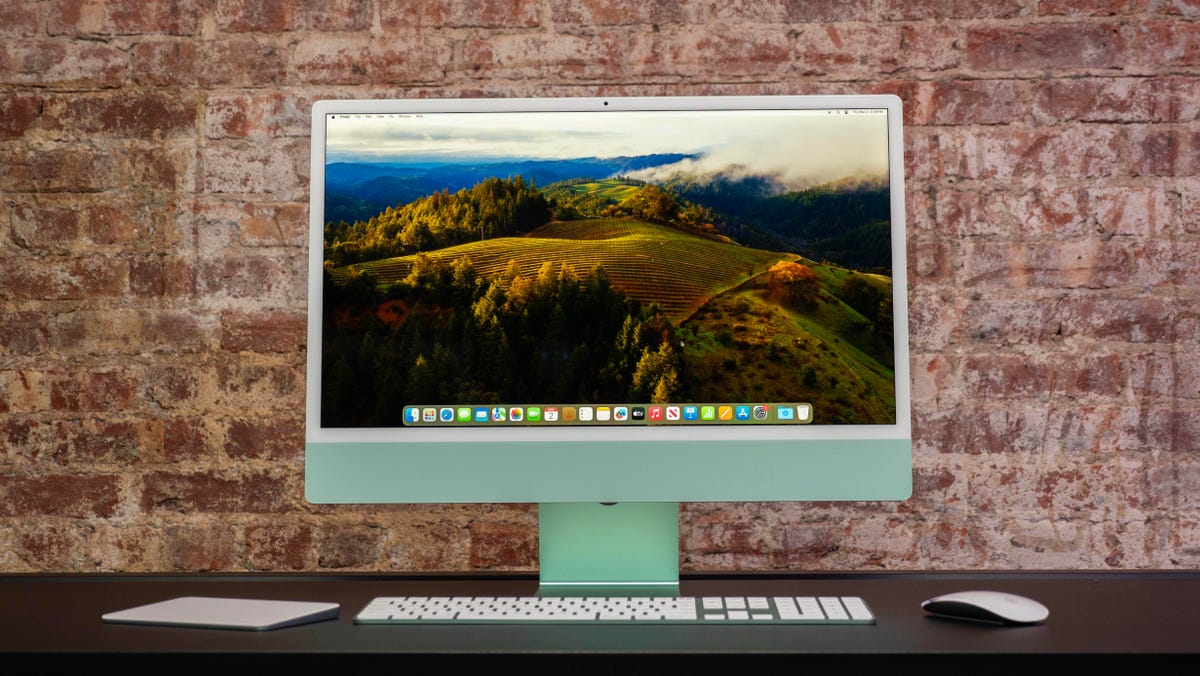
Apple iMac M3 configuration tested
| Price as reviewed | $2,299 |
|---|---|
| Display | 24-inch 4,480×2,520-resolution Retina |
| Processor | M3 8-core (4P, 4E) |
| Graphics | M3 10-core |
| Memory | 24GB |
| Storage | 1TB SSD |
| Wireless | Wi-Fi 6E (802.11ax), Bluetooth 5.3 |
| Connections | USB-C Thunderbolt/USB 4 (x2), USB-C 3.0 (x2), 3.5 mm headphone jack, Gigabit Ethernet (on power supply) |
| Operating system | macOS Sonoma |
The base model M3 iMac is $1,299 ( 1,399, AU$2,199) with an eight-core CPU and eight-core GPU, 8GB of unified memory and a 256GB SSD for storage. The version I tested was a $2,299 configuration with a 10-core GPU, and its memory maxed out to 24GB (up from a max of 16GB on the M1 iMacs), as well as more storage.
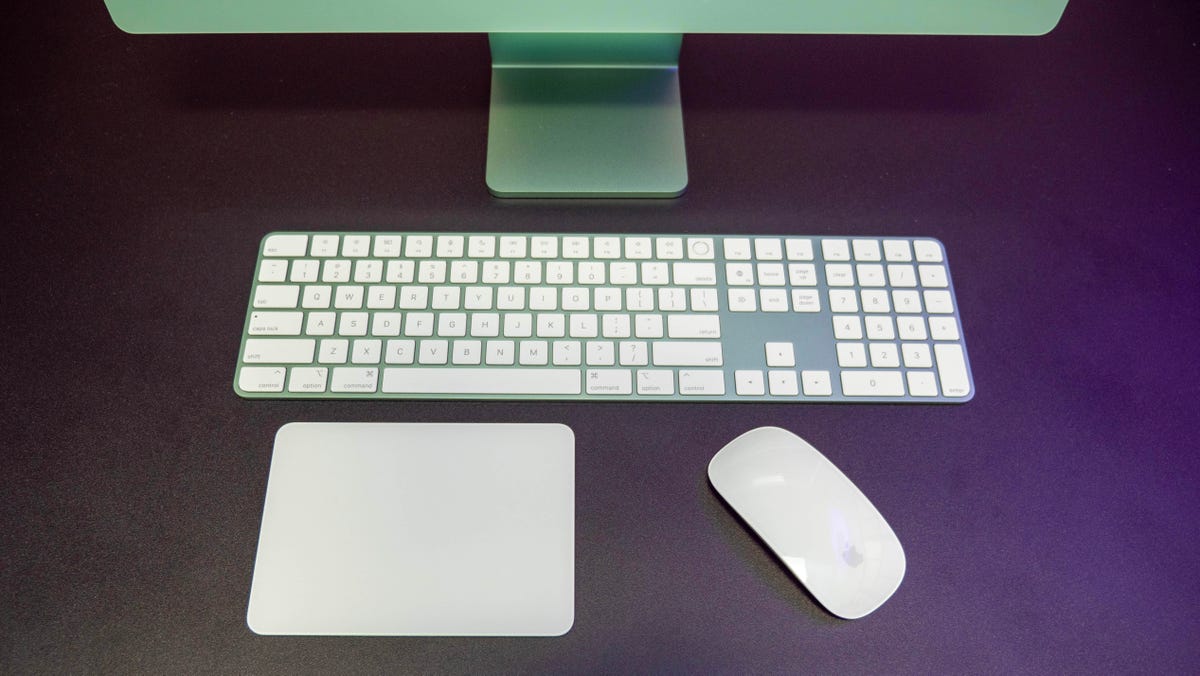
Apple currently offers three configuration starting points for the iMac, and decoding how they differ is only slightly confusing. Basically, the third option you’re presented with is nothing more than a storage bump from 256GB to 512GB. So, really, there are just two versions: the $1,299 base model and a $1,499 step-up model, and both are configurable with more storage and memory, and optional accessories. However, there are differences that are significant enough to spend the additional $200.
Here’s what you get with the $1,499 model in addition to what’s in the $1,299 base model:
- M3 chip with an eight-core CPU, 10-core GPU
- Two USB-C 3.0 ports (in addition to its two Thunderbolt USB-C ports)
- Gigabit Ethernet on the power supply
- Magic Keyboard with Touch ID
Also, by going with the $1,499 version, you get to choose from three additional colors — yellow, orange and purple — and a 2TB SSD. The Ethernet power adapter and keyboard with Touch ID are easily tacked onto the base model for $80 total. It’s worth the extra $120 to get the increased GPU performance and extra USB-C ports if you can afford it. It’s a bit irksome that $1,499 still only gets you 8GB of memory and a 256GB SSD, though. Many people should be fine with 8GB of memory for everyday use. If content creation or gaming is in your future, or you’re just a heavy multitasker, tack on another $200 for 16GB of memory, or $400 for 24GB.
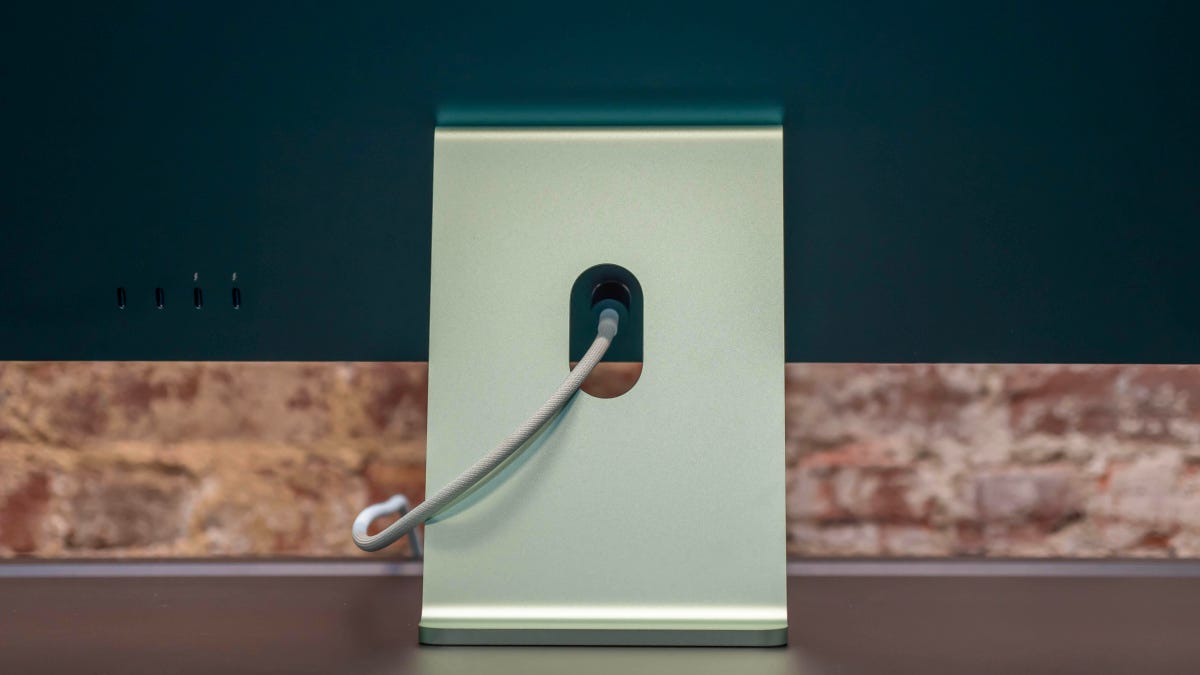
Performance to spare
Although I’ve only spent a few days testing the iMac M3, there’s no doubt about a leap in performance from the M1 and Intel-based iMacs. Basic day-to-day stuff isn’t an issue, and I imagine even if you went with the $1,299 M3 iMac, you’d be just fine for general school and home office tasks. Based on my early testing and benchmark results, spending more for the $1,499 model is worthwhile if you’re replacing an aging iMac or other all-in-one. For example, for the multicore test in Geekbench 5, the M3 iMac handily beat the M1 by more than 3,000 points, and it also topped the $4,500 27-inch iMac with a 10th-gen Intel Core i9 we tested in 2020. (Geekbench, 3DMark and Cinebench are available for personal use if you want to run them on your current system.)
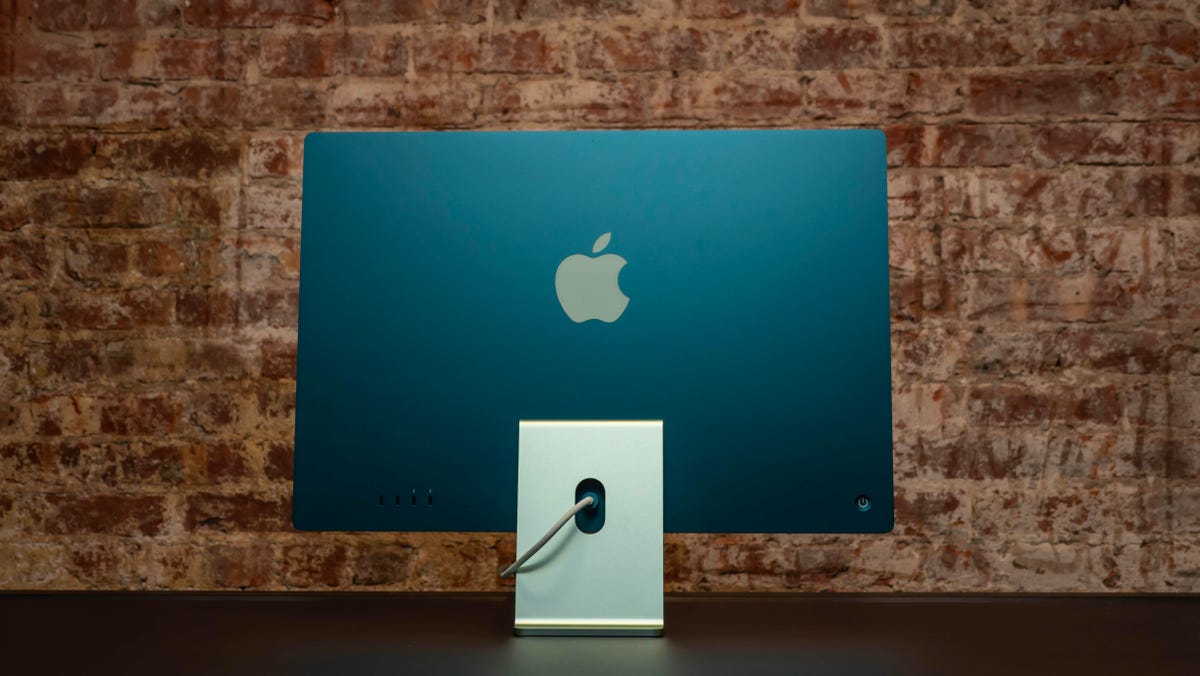
Apple talked up gaming on the iMac when it was announced, and after playing some Baldur’s Gate 3 and Disney Dreamlight Valley, I can see where this iMac could be an option for kicking back and playing some games. However, again, you’ll want to go with at least 16GB of unified memory if this is in your future. You can also take advantage of cloud gaming services like GeForce Now. The beautiful 24-inch display and outstanding audio quality from its six-speaker system certainly give you a more immersive experience. And if you want an additional display, one of the Thunderbolt 3 ports can be used for a monitor up to 6K at 60Hz.
If you’re considering the M3 iMac for content creation, the chip’s media engine supports hardware acceleration for ProRes and ProRes Raw in addition to H.264 and HEVC.
iMac M3 vs. iMac M1 vs. iMac Intel i9
- iMac M3 (2023)
- iMac M1 (2021)
- iMac Core i9 (2020)
iMac comparison specs as tested
| iMac M3 (2023) | Apple macOS Sonoma; Apple M3 (8-core CPU, 10-core GPU); 24GB unified memory; 1TB SSD |
|---|---|
| iMac M1 (2021) | Apple macOS Ventura; Apple M1 (8-core CPU, 8-core GPU); 16GB unified memory; 512GB SSD |
| iMac Intel (2020) | Apple macOS Catalina; 3.6GHz Intel Core i9-10910; 32GB DDR4 2,667MHz RAM; 16GB AMD Radeon Pro 5700 XT; 1TB Flash Storage |
The design is still simple and elegant
Like the 2021 M1 model, the iMac M3 is amazingly thin and compact, and it weighs less than 10 pounds. It comes in up to seven two-tone colors, with a lighter color under the display and for the stand and the large Apple logo on the back. The back is otherwise a darker color than the rest. The white screen bezel kind of diminishes the look, but it’s also reminiscent of the original fruit- and jewel-colored iMacs.
The built-in mics and full-HD webcam are both holdovers from the M1 iMac. The combination works well so you won’t be embarrassed on FaceTime chats and Zoom meetings, at least not because of the image and audio quality. However, since nothing has changed here, it also means there’s no Face ID.
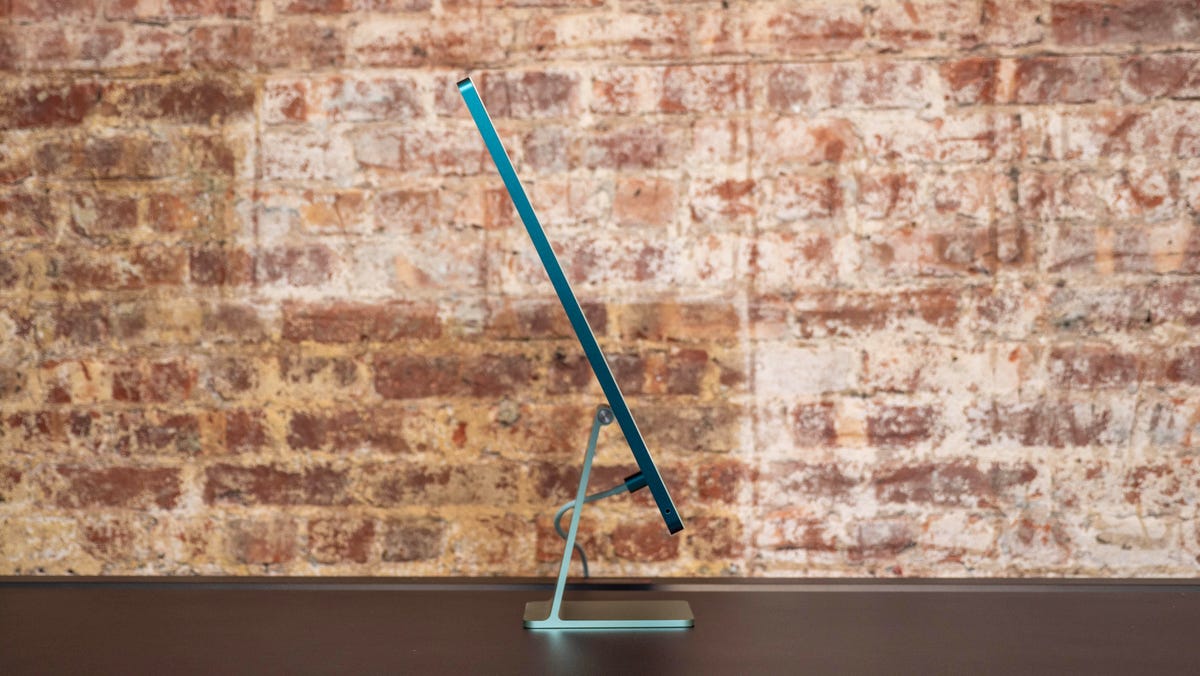
It might sound silly, but one of my favorite features of the current design is the power cable. It magnetically pops right into place, and nothing needs to line up perfectly, so there’s no struggle connecting it. And it holds on tight. Because this iMac is so slim and lightweight, it’s easy to move this around your home. Being able to detach and attach the power cord makes it even easier.
With only USB-C ports and a headphone jack (and an Ethernet jack with the more expensive power supply), you’re going to need a dock or dongles for other connections. The next time Apple updates the design, it would be great to see an SD card slot added to simplify using the iMac’s increased graphics performance for video and photo editing. And while I’m on my wishlist, it would be nice to see an option to add a tilt- and height-adjustable stand similar to the one available for Apple’s Studio Display (though not for $2,000 extra). For now, you can get the iMac M3 with a built-in VESA mount for a third-party stand or arm.

There was also the hope this time around that Apple would switch from Lightning to USB-C for charging the Magic Keyboard, Mouse and Trackpad. But no, not yet. The Magic Mouse charging port is still on the bottom, too. If you’d rather have a Magic Trackpad (I like it more than the mouse), it’s a $50 add-on and is color-matched to the iMac you choose, as are the keyboard and mouse. If you get the base iMac configuration, the keyboard doesn’t include Touch ID. Getting a keyboard with Touch ID is also $50 and, in my opinion, money well spent.
A do-everything all-in-one
Overall, I like the current iMac design a lot, both its looks and the size. I wish Apple would add an SD card slot next time around as it’s done with the MacBook Pro. A height-adjustable stand option would be nice also. Those are small considering the rest of the package, though.
The M3’s performance is a huge plus for everything from basic home office and school tasks to content creation. Just make sure you pick your configuration carefully with an eye toward how you’ll use it now and how that may change later. The 24-inch iMac seems especially well-suited as a family computer or if you want something other than a laptop to easily move from room to room. It’s small enough to squeeze into tighter spaces, like a kitchen nook, but big enough to spread out your work, kick back and stream a movie or do some casual gaming.

